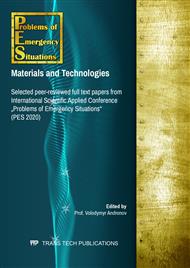p.19
p.25
p.32
p.41
p.47
p.55
p.62
p.70
p.79
Features of some Polymer Building Materials Behavior at Heating
Abstract:
The problems of reducing combustibility and increasing fire resistance of some polymer building materials are considered. And the toxicity of the gaseous products of their thermal degradation was evaluated both individually and in various combinations with each other. The features of thermal degradation and the loss of mechanical properties under the influence of a flame of polymer building materials were studied. The following samples were used: water pipes based on polyethylene; Tarkett linoleum, Ondex roofing products, Rolvaplast PVC profile panels; structural panels of the company "Polygal"; facing tile based on phenol-formaldehyde oligomers. The processes occurring during pyrolysis and combustion are considered, the results of a study of the combustibility and mechanical properties of polymer building materials based on polyethylene, polyvinyl chloride, polycarbonate, phenol-formaldehyde and epoxy oligomers under the influence of a flame are presented. For the studied building polymer materials, the products of pyrolysis and combustion were studied; their ignition and self-ignition temperatures, and also the flame propagation velocity were measured. The data on the toxicity of the products of their combustion, both individually and under combined action, are summarized. Also, for the studied polymer building materials, the losses of heat resistance, toughness, and flexural strength under the influence of a flame were studied. Thermogravimetric analysis of Rolvaplast PVC panels and Poligal polycarbonate panels allowed us to determine the maximum temperatures and activation energies of the polymer decomposition process. It was concluded that if the material is recognized as non-combustible or slow-burning, it will not always be fire resistant, since its strength and thermal properties can sharply decrease already in the first seconds of flame exposure.
Info:
Periodical:
Pages:
47-54
Citation:
Online since:
August 2020
Price:
Сopyright:
© 2020 Trans Tech Publications Ltd. All Rights Reserved
Share:
Citation:


